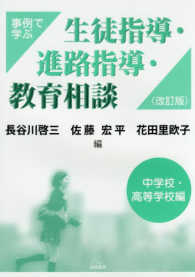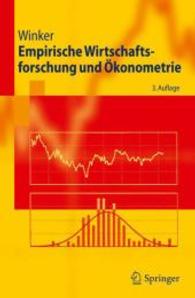- ホーム
- > 洋書
- > ドイツ書
- > Mathematics, Sciences & Technology
- > Technology
- > mechanical engineering & production engineering
Full Description
This book details the application of advanced characterisation techniques and diagnostic tools to heritage science, including the evaluation of heritage assets' condition, their preservation and restoration.
It examines the use of electrochemical techniques in conservation science, with a particular focus on how to solve problems in taking on-site measurements. Specifically, it introduces readers to a new gel polymer (GPE) electrochemical cell developed by the authors for the characterisation of metallic heritage objects. Other techniques used to characterise and monitor reinforced concrete objects in more modern buildings are also covered, including non-destructive electrochemical techniques that allow steel corrosion to be assessed in these structures, and in those that are used to protect and repair such buildings.
The usefulness of the NMR-Mouse nuclear magnetic resonance sensor in the assessment and preservation of softer heritage materials, such as wood, parchment,bone, and painted walls, is covered, as well as Infrared reflectography for examining paintings and laser cleaning for restoring them. The book introduces ultra-High Performance Liquid Chromatography (u-HPLC) with a diode-array (DAD) and mass-mass (MS-MS) quadruple time-of-flight spectroscopy (QTOF). This new technique can be applied to the analysis and identification of natural and synthetic organic pigments and its use is demonstrated in several case studies.
This book provides a rigorous scientific grounding in the application of state-of-the-art techniques in heritage science and conservation, and offers a practical handbook for practitioners.
Contents
Chapter 1. In-situ corrosion diagnosis in contemporary built Heritage, David M. Bastidas.- Chapter 2. Electrochemical techniques for in-situ corrosion evaluation of Cultural Heritage. Emilio Cano.- Chapter 3. Development of advanced spectroscopic and immuno based methods for the identification of proteinaceous substances in paint cross sections, Rocco Mazzeo.- Chapter 4. Multispectral IR reflectography for painting analysis, Raffaella Fontana.- Chapter 5. Non-invasive molecular spectroscopy for in situ analysis of painting materials, Constanza Miliani.- Chapter 6. Optical Coherence Tomography (OCT) - a novel tool for examination of artworks, Magda Iwanicka.- Chapter 7. Non-invasive and portable techniques for diagnosis and conservation assessment in geomaterials structures, Mónica Álvarez de Buergo.- Chapter8. New approaches for Green Museums. Biosensors technology for detecting microbial development in microenvironments and application of natural extracts for elimination of biological agents in historic collections. Nieves Valentín.- Chapter 9. Gypsum detection by imaging techniques in the near infrared region. Carmen Vega.- Chapter 10. Concepts and applications of the NMR-Mouse. Bernhard Blümich.- Chapter 11. Ultra-HPLC coupled to UV-Vis and tandem MS-MS detection. Advanced applications on chemical micro-analysis of organic pigments. Enrique Parra.- Chapter 12. Infrared thermography for built heritage diagnosis. Miguel Gómez-Heras.- Chapter 13. Cultural heritage monitoring based on wireless sensor networks for a preventive conservation, Mª Inmaculada Martínez GarridoChapter 14. Laser removal of biodeteriogen layers on heritage stone. Mohamed Oujja.- Chapter 15. Analysis of historic glasses by laser spectroscopies. Mikel Sanz.- Chapter 16. Laser cleaning of paintings and mitigation of side effects. Esther Carrasco.- Chapter 17. Laser spectroscopy in the analysis and diagnosis of CH objects and monuments; portable instruments and case applications. Laser cleaning in CH objects and monuments; a tailored relation Paraskevi Pouli.- Chapter 18. Thread counting in X-rays of plain-weave painting canvas, Laura Alba and Juan José Murillo Fuentes.








